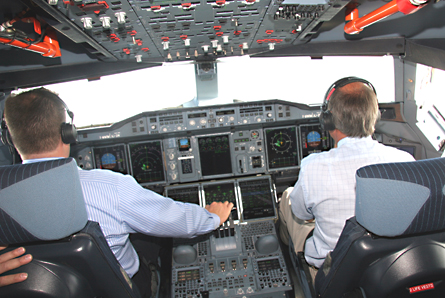Flight International’s test pilot Mike Gerzanics got his hands on the Airbus A380 yesterday and discovered that this giant airliner actually flies more like a small one.

Mike Gerzanics and Airbus pilot Peter Chandler at the controls
In a sneak preview ahead of his full flight test report which will be published in Flight International shortly, Gerzanics gives his first impressions flying the world’s largest airliner.
The 3h 30min flight from Toulouse was made in the first A380 test aircraft (MSN001/F-WWOW) – the high time machine with over 1,000h logged.
Gerzanics says that taxiing the double-decker with its 79.6m (261ft) wingspan is relatively straight-forward despite the size, thanks to the well-positioned taxi cameras which display on the pilot’s primary flight display (PFD): “This allows the nose gear to be placed accurately on the centre line...it is extremely easy to taxi on congested ramps and narrow runways.”

Taxi camera display
Although the A380 flightdeck configuration borrows extensively from its predecessors, it is more expansive thanks to the wider nose section which provides enough room for much larger flight management system (FMS) displays on the centre console. Gerzanics adds that “the primary flight and navigation displays are also much deeper, enabling them to provide vertical flightpath information and other features to give increased situational awareness”.
But Gerzanics feels that in Airbus’s efforts to retain a strong link with earlier fly-by-wire models, the A380’s flightdeck, although well advanced over its predecessors, “lags behind the latest cockpits available on Dassault and Gulfstream business jets”.
The A380 continues the normal Airbus trend of full envelope protection, he says: “The FBW flight control system makes potentially disastrous asymetric loss of thrust at low speeds situations quite benign.”
When sampling the A380’s high speed performance at 30,000ft (9,150m), no buffet was experienced at its Mmo/Vmo speed of 0.89/340kt. The low speed handling was also impressive, says Gerzanics. “Despite its size, the A380 displays agility in the radar traffic pattern close to the airport - it is a ‘big aircraft that ‘flies small’.”
On final approach, the large chord wing and expansive flaps allow for markedly low approach speeds for such a large aircraft, he adds. “At a landing weight of 350t, the bugged landing speed (VLS) was 131kt, and the rate of descent on touchdown was less than 2ft/sec (0.6m/sec) – the 20 wheel, four-bogie main landing gear absorbing the arrival smoothly. Touchdown de-rotation is much smoother than the A340-600.”
In summing up his A380 experience, Gerzanics says that Airbus has created a docile giant with performance that belies its huge dimensions: “It was a surprise that this huge aircraft was such a delight to fly, and that ground-manoeuvring also presents no dramas.”
Max Kingsley-Jones is the first journalist to fly on the A380. Read his blog on the test-flight with more pictures here.
Source: FlightGlobal.com























